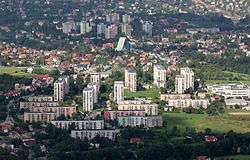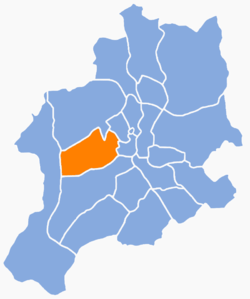Aleksandrowice, Bielsko-Biała
Aleksandrowice (German: Alexanderfeld) is an osiedle (district) of Bielsko-Biała, Silesian Voivodeship, southern Poland. It is located in the central-west part of the city, in Silesian Foothills. The osiedle has an area of 1.6988 km2 and on December 31, 2006 had 1,821 inhabitants.[1]
Aleksandrowice | |
|---|---|
 Aerial view of Aleksandrowice | |
 Location of Aleksandrowice within Bielsko-Biała | |
| Coordinates: 49°48′52″N 19°14′00″E | |
| Country | |
| Voivodeship | Silesian |
| County/City | Bielsko-Biała |
| Area | |
| • Total | 1.6988 km2 (0.6559 sq mi) |
| Population (2006) | |
| • Total | 1,821 |
| • Density | 1,100/km2 (2,800/sq mi) |
| Time zone | UTC+1 (CET) |
| • Summer (DST) | UTC+2 (CEST) |
| Area code(s) | (+48) 033 |
History
The settlement arose after parcellation of a local folwark situated then in the southern part of Stare Bielsko which took place in years 1787–1790. It was later industrialized in part with a wider industrial growth of Bielsko and its surroundings. Politically it belonged then to the Duchy of Bielsko, within the Habsburg Monarchy.
After the Revolutions of 1848 in the Austrian Empire a modern municipal division was introduced in the re-established Austrian Silesia. The village became a part of the municipality of Stare Bielsko that was subscribed to the political and legal district of Bielsko. It became a separate municipality in 1864.
According to the censuses conducted in 1880, 1890, 1900 and 1910 the population of the municipality grew from 1797 in 1880 to 2426 in 1910 with a majority being native German-speakers (between 77.3% and 87.3%) accompanied by a Polish-speaking minority (at most 22.1% in 1890) and a few Czech-speaking people (at most 12 or 0.6% in 1890), in terms of religion in 1910 majority were Protestants (50.4%), followed by Roman Catholics (47.5%), Jews (51 or 2.1%) and 2 persons adhering to yet another religion.[2][3] It was then considered to be a part of a German language island around Bielsko (German: Bielitz-Bialaer Sprachinsel).[4]
After World War I, fall of Austria-Hungary, Polish–Czechoslovak War and the division of Cieszyn Silesia in 1920, it became a part of Poland. It was then annexed by Nazi Germany at the beginning of World War II. After the war it was restored to Poland. The local German-speaking population fled or was expelled.
Aleksandrowice became administratively a part of Bielsko in 1938 (Bielsko-Biała since 1951).
References
- Rada Miejska w Bielsku-Białej (21 December 2007). "Program rewitalizacji obszarów miejskich w Bielsku-Białej na lata 2007–2013" (PDF) (in Polish). pp. 9–10. Archived from the original (PDF) on 22 May 2015. Retrieved 21 May 2015.
- Piątkowski, Kazimierz (1918). Stosunki narodowościowe w Księstwie Cieszyńskiem (in Polish). Cieszyn: Macierz Szkolna Księstwa Cieszyńskiego. pp. 257, 276.
- Ludwig Patryn (ed): Die Ergebnisse der Volkszählung vom 31. Dezember 1910 in Schlesien, Troppau 1912.
- "hałcnowski i bielsko-bialska wyspa językowa". inne-jezyki.amu.edu.p (in Polish). Dziedzictwo językowe Rzeczypospolitej. 2014. Archived from the original on 6 October 2014. Retrieved 12 September 2014.